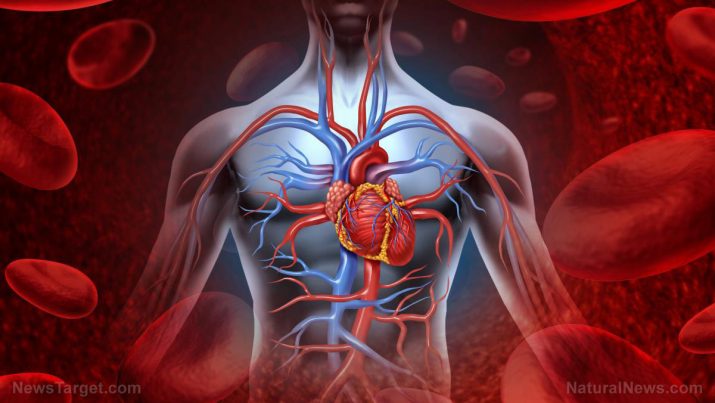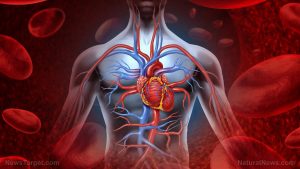
Cardiovascular disease – causes, side effects and treatments at NaturalPedia.com
Thursday, February 15, 2018 by Ralph Flores
http://www.naturalpedia.com/cardiovascular-disease-causes-side-effects-and-treatments-at-naturalpedia-com.html

Cardiovascular disease (CVD) is a general term used to describe various ailments that affect the heart and blood vessels. Many of these problems are linked to atherosclerosis, a condition where plaque – a substance made up of fat, cholesterol, calcium, and other substances – builds up on the artery. Over time, the condition hardens the arterial wall and reduces the inner channel (lumen) of the artery which restricts the flow of blood.
The condition is further complicated when the plaque ruptures or is eroded. This will result in the formation of a blood clot (thrombus), which blocks the arteries and can lead to a heart attack or stroke.
According to the World Health Organization (WHO), CVDs are the leading cause of death globally. In the U.S. alone, the Centers for Disease Control and Prevention (CDC) estimates that the condition accounts for at least 25 percent of the deaths each year.
While CVD is a generic term for heart and blood vessel disorders, there are different types of the condition, which target different parts of the cardiovascular system.
- Coronary heart disease (also called the coronary artery disease) is the most common form of CVD, and it accounts for at least 60 percent of all heart disease deaths in the U.S., according to the CDC. Coronary heart disease happens when plaque buildup is located in the arteries that go to the heart. When the blood vessels narrow down, this reduces the blood flow going to the heart. This may lead to angina – chest pains caused by the limited blood flow to the heart. If the plaque ruptures and blood clots entirely block the artery, a person will most probably suffer a myocardial infarction – commonly referred to as a heart attack – where the lack of blood flow has caused the heart muscle to die.
- Heart failure happens when the heart weakens to the point where it cannot pump enough oxygen-rich blood to sustain the body’s needs for blood and oxygen. The condition occurs in various forms – either when the heart cannot pump blood out of the veins properly (called systolic heart failure) or does not readily replenish its blood flow (called diastolic heart failure). When the heart cannot pump efficiently, blood may retreat to other areas such as the lungs, liver, gastrointestinal tract, and extremities cause a fluid buildup. This is called congestive heart failure.
- Arrhythmias affect the pulse (heart rate) or heart rhythm. The condition occurs when the heart’s electrical system does not properly function. This causes the heart to have uneven beats, which can either be too fast or too slow.
- Heart valve diseases affect the four valves in the heart, which can either make the blood flow in the opposite direction or block blood flow as a result of the valve not opening far enough. This can either be a result of heart disease, a previous heart attack, or an infection.
- Peripheral artery disease happens the vessels that supply blood to the legs and feet become clogged with plaque buildup. This can lead to blood clots that block smaller arteries, tissue death in the leg, and ischemic ulcers on the lower legs.
- Hypertension (high blood pressure) is a CVD that indicates a person is at risk for more severe complications like heart attack, heart failure, and strokes.
- Strokes occur when the heart cannot pump enough blood to the brain. Both types of stroke can happen when the brain does not get enough blood, either due to a blood clot (called an ischemic stroke), or when a weakened vessel ruptures because of high blood pressure (called a hemorrhagic stroke).
- Congenital heart disease is a CVD that results from a problem with the heart that is present at birth. The condition is common – it affects one percent of at least 40,000 births in the U.S. per year.
Aside from its effects on a person’s health, it can also negatively impact the economy. In the U.S., around $200 billion is lost each year because of CVDs.

Known risk factors and symptoms of cardiovascular disease
The etiology of CVDs is still unclear; however, various risk factors indicate how likely a person is to develop the condition. These include:
- Age: A person over 40 years old should have regular check-ups every five years.
- Hypertension: A high blood pressure could increase the risk of stroke.
- Smoking and tobacco use: The nicotine in cigarettes can activate mechanisms that lead to atherosclerosis.
- LDL cholesterol: High levels of low-density lipoprotein, or LDL, is a risk factor in plaque buildup.
- Diabetes: High blood sugar levels brought about the condition – namely Type 2 diabetes – damage blood vessels and cause them to narrow down.
- Inactivity: Studies have shown that a sedentary lifestyle increases the mortality risk because of a CVD.
- Being overweight or obese: Aside from diabetes, people who are overweight or obese are more likely to have a CVD. In particular, people with a body mass index of (BMI) of 25 or more and have a waist measuring more 94cm (about 37 inches) for men and 80cm (about 31.5 inches) for women are likely candidates.
- Family history: A person who has a family member that was diagnosed with a CVD also has a high likelihood of getting the condition as well.
Other risk factors such as diet and alcohol consumption are modifiable and can be consciously monitored.
The initial signs of a CVD may include:
- Classic symptoms of angina (e.g. pain from the chest that radiate to the left arm, as well as crushing sensation in the center of the chest)
- Shortness of breath
- Sweating
- Nausea
- Indigestion
- Pain in the upper abdomen, shoulder, or lower back
In some cases, the pain from angina can wake a sleeping person from sleep.
Not all CVDs exhibit the same sign and symptoms, as the noted symptoms may also be a result of other pre-existing conditions such as diabetes. However, a clear indicator of the progression of CVD is that the initial symptoms become worse over time, partly because of the gradual buildup of plaque in the arteries.
In some cases, the first indicator of the onset of a CVD is a heart attack – which is characterized by a crushing pressure to the chest, shortness of breath, profuse sweating, and in worse cases, cardiac death.
Body systems affected by cardiovascular disease
Cardiovascular diseases primarily target the heart, one of the most vital organs in the human body. It then extends to the circulatory system, which provides cells in the body with oxygen and nutrients found in the blood that will enable them to function fully. Once this is affected, various organ systems are affected: Problems with metabolism will occur, the brain will be unable to operate with the lack of blood, a shortage of blood to the kidney will cause renal failure, and muscles and nerves in the legs will be damaged when peripheral artery disease sets in.
Women with CVDs are also at risk: Congenital heart disease increases the mortality risk of both mother and child as blood is not effectively distributed to the growing fetus.
Food items that may prevent and relieve cardiovascular disease
Aside from age, gender, and family history, almost all risk factors in CVD can be attenuated with a healthy lifestyle – of which diet plays a big part of.
In the U.S., the Department of Agriculture and the Department of Health and Human Services have launched the MyPlate program which is aimed to curb CVDs incidences through a well-rounded diet plan.
The plan focuses on five food group categories that allow the person to develop a personalized diet (based on his gender, age, and the availability of food items) that still meets the required daily amount of nutrients to improve health.
- Grains – These include wheat, rice, oats, cornmeal, and barley.
- Vegetables – Excellent additions include dark green, red, and orange vegetables. Beans, peas, and starchy vegetables form part of this group as well.
- Fruits – For juice to be part of this group, it has to be 100 percent fruit juice. Whole fruits can be either fresh or dried and be eaten raw or pureed.
- Dairy – Milk and its derivatives are part of this group. The diet calls for low-fat or fat-free options and those that are high in calcium.
- Protein – Poultry and lean meats are recommended, as well as fish, nuts, seeds, peas, and beans.
The MyPlate program recommends using oils that have essential nutrients that a person needs, as well as avoiding animal fats to reduce the risk of CVD.
According to U.K.’s National Health Service, coupling a healthy diet with at least 150 minutes of “moderate aerobic activity” a week and cutting back on alcohol also helps keep CVD at bay.
Treating and managing cardiovascular disease
There are specific medical treatments for each CVD, but in general, healthcare professionals recommend taking in medication to treat the onset of CVD.
- Aspirins are used to make platelets less sticky and reduce the incidence of blood clot formation.
- Beta-blockers are used to manage the effects of adrenaline in the heart, reducing the heart rate and helping it function efficiently.
- Calcium channel blockers allow the muscle to pump efficiently.
- Nitrates help with increasing blood flow to cardiac muscles. They are also used to treat the onset of angina or prevent future recurrences of it.
When there is significant blocking of the arteries, surgical procedures such as angioplasty or stenting may be used to open up the affected artery. In severe cases, a coronary artery bypass graft surgery (CABG) may be needed for treatment.
Where to learn more
- The health of your gut microbiome could predict your risk of heart disease, researchers find
- Women who suffer from migraines at higher risk of a stroke
- Cardiovascular disease – how to beat it by reversing ‘inflammatory living’
- Statin scam worsens cardiovascular disease epidemic
- Sugar linked to cardiovascular disease, as well as other chronic diseases
Summary
Cardiovascular disease (CVD) covers all conditions that adversely affect the heart and blood vessels. While there are risk factors that cannot be changed like age, gender and family predisposition, proper diet, regular exercise, and an active lifestyle can help reduce the likelihood of the disease.
Sources include:
Tagged Under: Tags: cardiovascular disease





